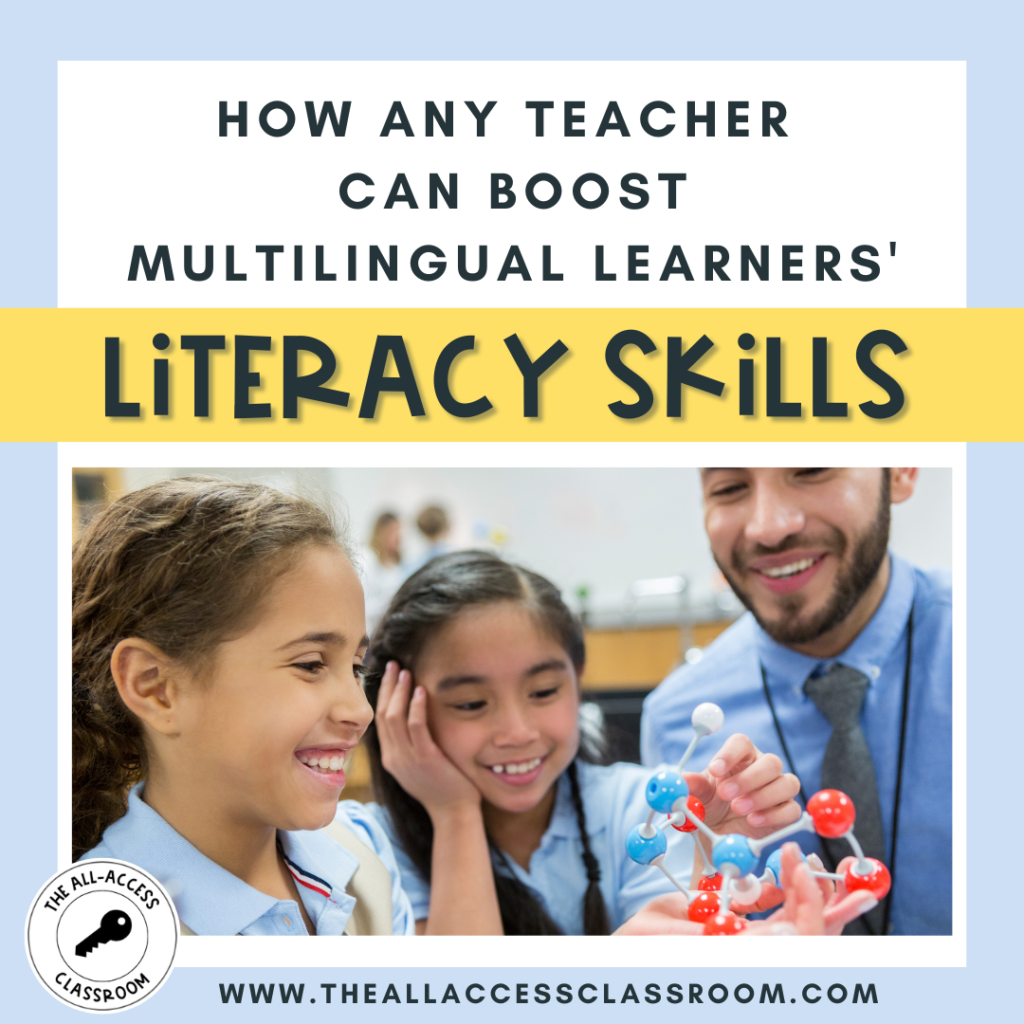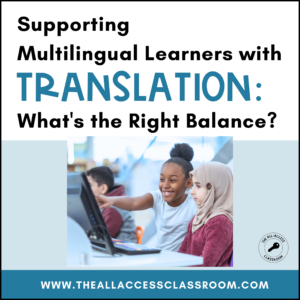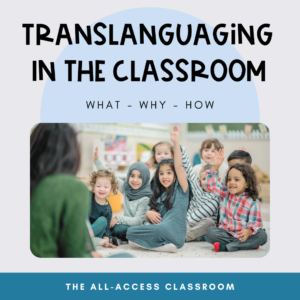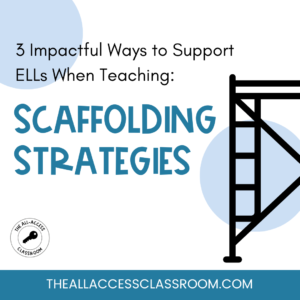I’m writing this blog for all my content (and ESL) teachers out there who may be searching for their role in helping multilingual learners build literacy skills. You may have a student in your class who has recently arrived in the U.S., having had interrupted education. This student spends a good chunk of their day sitting before you, but not yet able to access written text in any language. Or perhaps you have a student with strong primary language literacy, but their language differs from English in many ways. Even though these emerging bilinguals have daily English development support, you really want to leverage your instructional time to help them. The “how” part…That’s where you may feel stuck. You’re not alone.
Here’s the good news! There is a LOT you can do, my friend, to help your students with word recognition and language comprehension in English. I have some ideas to share with you that hopefully give you a starting point.
Foundational Literacy Skills? But I’m not a Literacy Specialist or Reading Teacher!
I get it…You didn’t exactly sign up to teach kids how to decode words. How to recognize morphological clues. Which phoneme is used for “ie” in friend. You teach math, or 8th grade science, or 4th grade Social Studies. Maybe you are an English teacher, but you do novel studies. You’re used to the majority of your students coming to you with basic English literacy skills. There’s usually another teacher coming alongside to support struggling readers.
Times, they are a’changin’, though, and increasingly we have students joining classrooms at all grade levels, in all subjects, who are building essential literacy skills. If they are in the gen. ed. setting for the majority of the school day, just think how much growth could come from supporting their literacy development in context? Notice I didn’t say teaching literacy. It would be unfair to expect you to suddenly be an expert in the Science of Reading, or to put your instruction on hold to take on a comprehensive reading curriculum. There does need to be focused support provided outside of your class…
But What If…
What if you had a lovely little collection of quick strategies up your sleeve? Some heightened awareness of the opportunities that will arise within your lessons, which create openings to reinforce and practice literacy skills in context? What if, in each lesson, you could create a language and literacy “moment” with all of your students? I’d wager that not only your ML students would benefit. This could also benefit your students with learning difficulties, as well as those who just haven’t yet received the systematic, consistent literacy teaching they deserved.
Dr. Jessica Costa puts it this way: “By virtue of the heterogeneous nature of their classrooms, mainstream classroom teachers have the ability to provide MLs opportunities to develop authentic linguistic and social connections that facilitate their new language development.” (Costa, 2023)
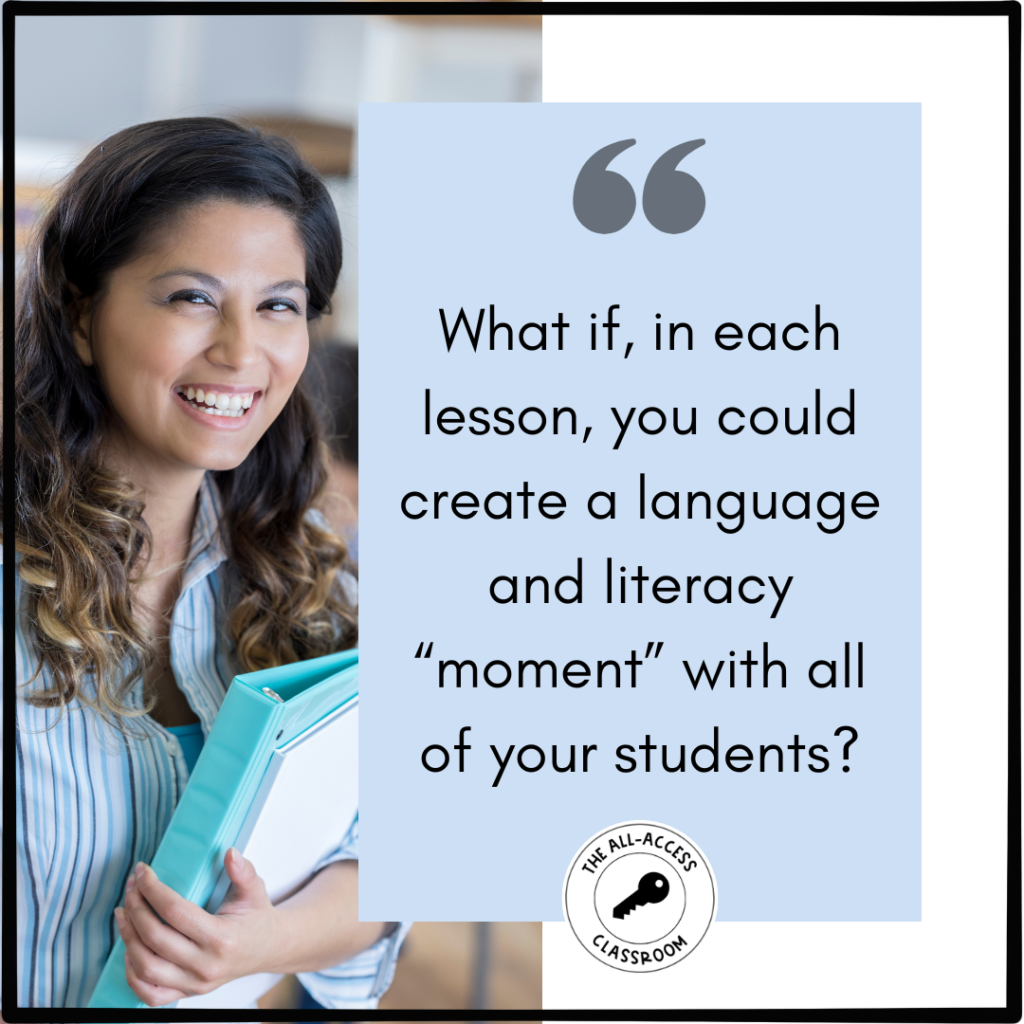
This is not meant to create more stress for you. Heavens, no. We are all in progress when it comes to understanding how students learn to read and write. It takes training, and it takes time. I won’t dare to step into all the ins and outs of reading instruction here, but I would encourage you to pursue professional development in this, as you’re able. No matter what grade level you teach, it will be well worth your time. We are all of us language and literacy teachers, because at the end of the day, our students require language and literacy in order to learn our content in the first place, right?
Here are some of those lovely quick strategies I’d love for you to tuck up that sleeve of yours, and whip out when the next language and literacy “moment” arises. No Science of Reading certification required (though a little self-motivated professional development never hurt anyone). 🙂
Ways to Infuse Any Lesson with Literacy and Language “Moments”
Literacy and language are already quite present in everything you do in the classroom! Students are listening, speaking, reading, and writing. They’re doing this at the word level, sentence level, and extended discourse level. Your multilingual learners come to your classroom with existing assets. If you know your students well, you can begin to gauge their needs. You can predict what may be new or challenging for them. You can intentionally teach skills that move them forward, and help them make connections between their primary language and English.
You’ll start to notice that in the middle of teaching, something will come across your “literacy radar”–a sound (phoneme), a letter combination (grapheme), a bit of figurative language, a multiple meaning word, or a suffix that happens to show up in a text five times–and you’ll want to do your students a favor by giving it some attention.
Here’s what that could look like:
Pronunciation Practice
Get your students talking and practicing the sounds of English! We know from reading research that speech comes before print. Have your students verbally repeat words or text after you, or chorally read as a class.
Lingering on an Orthographic (Spelling) Feature that May be Tricky or New for Students
[Me reaching through the screen to put my hands on your shoulders]: It’s okay if you don’t know every sound-spelling correspondence rule or explanation. (One could study this stuff for years!) In your lesson, just gently pause when you feel led to highlight an interesting spelling feature. Circle it, have students say it, copy it…put a few other words up that share the same sound and spelling, to help students build recognition of the feature…However you want to highlight it will be amazingly helpful!
Having a Literacy and Language Feature “Of the Week”
So many variations and possibilities for this one! Establish a space on the board or wall of your classroom for a “____ of the Week.” Depending on your context, you could do something morphology-based (i.e. “Suffix of the Week,” “Word Stem of the Week”). Or sound-based (i.e. “Phoneme of the Week”). You might do an “Idiom of the Week” or “Academic Vocabulary Word of the Week.” Just introduce the highlighted feature on Monday, and challenge the students to look out for examples. You can provide additional mini-lessons sprinkled in, as well! Students could add sticky notes to your wall space, or throw up a hand (or sound effect!) when they spot the feature.
Explicit Vocabulary Instruction
This is kind of a no-brainer, but any time you can explicitly teach new vocabulary, you are equipping your students with one of the most important tools they need to carry. Vocabulary is essential for their language comprehension, and there are lots of ways to make room for it in your lessons! Here’s one routine that I like.
Make it Visual
Let’s say you’re teaching math and working with students on orally sharing their reasoning/procedures. You plan to provide sentence stems to assist them in their explanation. Maybe as a precursor to this, you could discuss some of the verbs (i.e. add, subtract, find, draw) and how to use the past tense of the verbs (i.e. added, found, drew, etc.) Language for the win! Now to make it visual, make a quick anchor chart as you go, and keep it up for student reference. Or, next to your sentence stems, provide a wee word bank, with the past tense forms of the verbs to be used.
Other ways to make language features more visually spotlighted could include highlighting, circling, using color, drawing, or using gestures/movement to support comprehension.
A Permanent Spot for Oral Language Supports
Your students need to be talking. Like, all the time. They have to say words before they are ready to read and write them. Guided student talk should be a regular part of your instruction, and sentence stems/frames can support MLs in this. Consider establishing a permanent wall, board, or poster pad where students know they will be looking for these supports. (Just make sure to model, practice, and differentiate as much as needed, so they are prepared to use this resource independently!)
Record Yourself
As our ML students learn the sound and language patterns of English, repetition is super helpful to establish new language connections in the brain. Before a new unit, hop on Canva or a screen recorder. It can be as simple as displaying a list of the new vocabulary (with images) and clearly reading the list, modeling pronunciation and maybe an example of use. Or, record yourself reading aloud a content-related text to build related vocabulary and schema. The benefit? Students can view and practice multiple times!
Point Out Cognates
[Hands on shoulders again]: You don’t have to be fluent in the students’ languages and be familiar with all the cognates (words that look, sound, and have meanings similar to English words). But it is pretty cool when you do come across one to point out to students. Heck, they’ll let you know when they find them! Here’s a neat list of some Spanish-English cognates. When curious, Google Translate can often help, if you input some content-related text.
Build Background Knowledge Using Visual Formats
If you are taking some time to build background knowledge before launching into new content, be sure to not only talk about the information, but incorporate visuals as much as possible. Using videos, photos, and maps can ensure that even students with emerging literacy can make personal connections to the content.
Slow Down Speech
Your beginning English learners are developing phonological awareness and familiarity with the sounds and rhythms of English. Slowing down your rate of speech and speaking clearly will assist them in differentiating and identifying sounds and words.
Point to Words as You Say Them
Helping students track with you as you read will really help them associate spoken sounds and words with their graphemes (written representation). World languages can vary in directional orientation, so tracking as you read can also build initial print awareness.
Emphasize Syllable Breaks when Introducing Multisyllabic Vocabulary Words
Like slowing your rate of speech, this will strengthen students’ phonological awareness and listening comprehension. Bonus: It will help all of your students learn to encode and spell the word independently.
Sound Wall (with Familiar Images as Representations/Examples of Sounds)
A sound wall displays each sound in the English language, along with each sound’s various spellings. This can be extremely helpful for students building oral English skills. Want to increase student engagement and connection to the word wall? With each sound, include images of real-world items that students are already familiar with, such as pop culture figures, brand names, or other environmental print. For example, under the /th/ sound, put up a picture of Thor, or under the /ch/ sound, a Cheetos bag.
Notice Features that “Show Up a Lot,” and Use Mini-Lessons to Teach Them in Context
If you’re using a nonfiction article with your students, and note that there are a lot of abbreviations of titles used throughout (i.e. Dr., Mr., Mrs.), take a 10-second pause as you read the article, and write the abbreviation on the board, along with the full word it represents. Have the students repeat each one as you explain. It can be as simple as that. Often, patterns or repeated language are already there in the academic text for us…paving the way for teachable moments and student meaning-making!
There ya have it! These are some of the simplest strategies I can think of, which don’t take much time!
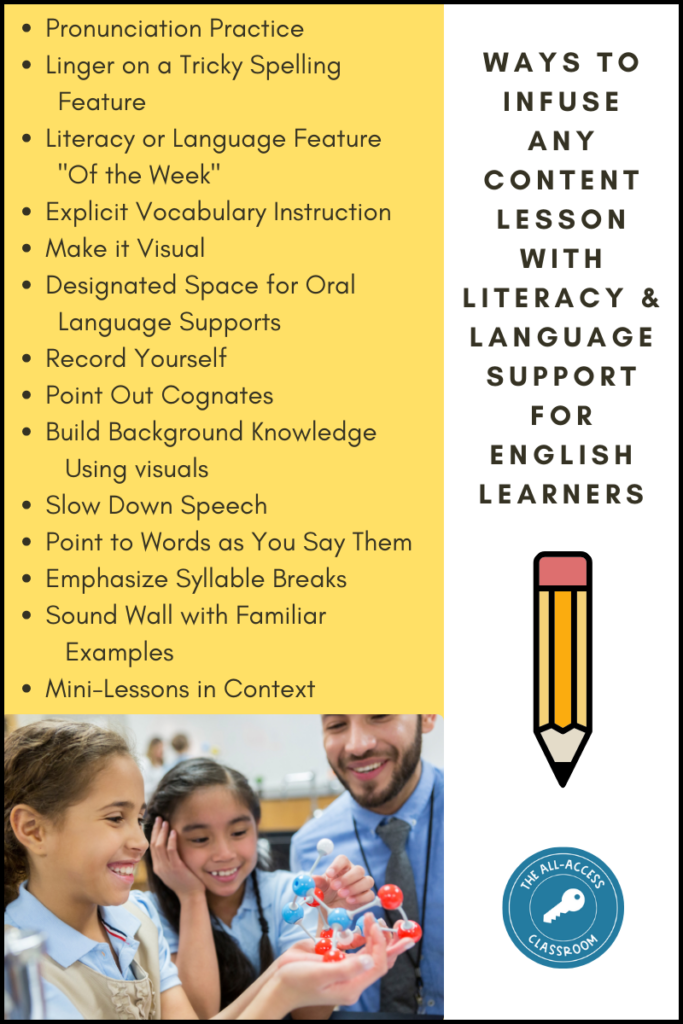
The Secret Sauce: Knowing Which Literacy Skills to Reinforce
As you “infuse” your instruction with language and literacy moments, there is one key element that will really step up your game: teacher collaboration. You need this. The more you collaborate with the multilingual learner specialist and others in your building, the better you’ll be able to provide the right support for each student. Your colleagues may have resources, assessment tools, teaching ideas, and knowledge of the students. If your current scheduling structure inhibits collaboration, start advocating for increased common planning time. Collaboration is truly powerful when it comes to supporting multilingual learners.
More Learning and Resources
Keep scrolling down to grab a free template for adding a language objective to each of your lessons!
Literacy for Older Newcomers, What is Practical and Effective (Carol Salva’s Boosting Achievement Podcast)
Literacy Instruction for English Language Learners (Colorin Colorado)
Structured Literacy Among English Learners: What Every Educator Should Know (with Dr. Elsa Cardenas-Hagan, via YouTube)
Mylanguages.org (great tool for understanding language differences!)
95 Percent Group’s professional development offerings – All based on literacy research
Common misconceptions about teaching multilingual learners to read (Costa, Instruction Partners, 2023)
I hope you took away some strategies that can be used in your classroom! Let me know which ones are your “gotta try” favorites!


